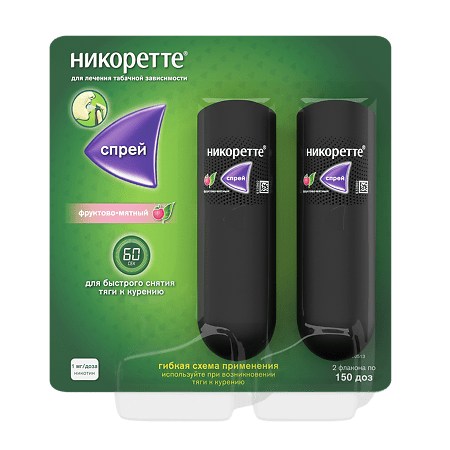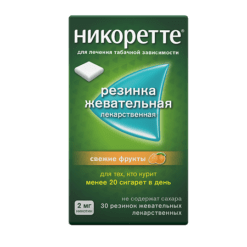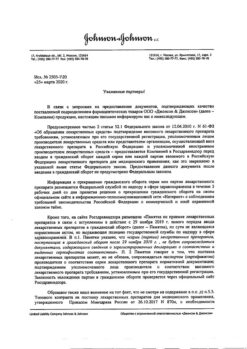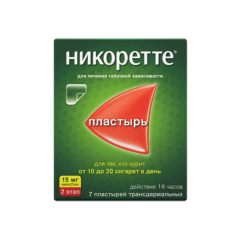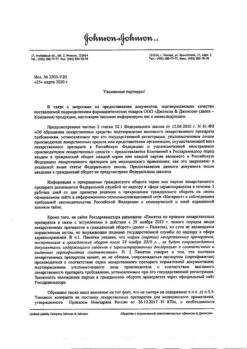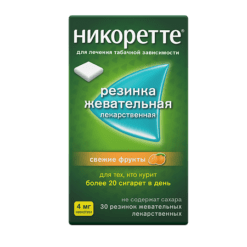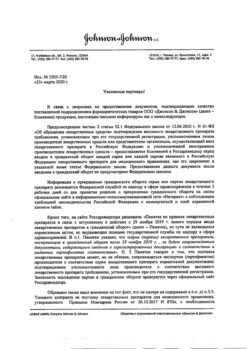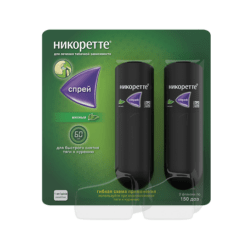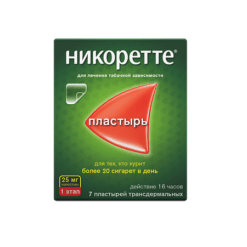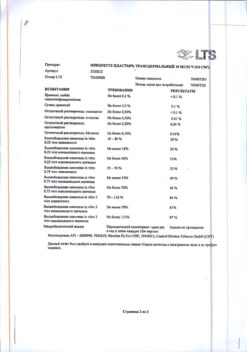No products in the cart.
Nicorette, spray 1 mg/dose 150 doses of fruit and mint 2 pcs
€60.39 €50.32
Description
Pharmacotherapeutic group: treatment of nicotine addiction.
ATC code: N07BA01.
Pharmacodynamics
Nicotine is an agonist of nicotinic receptors in the peripheral and central nervous system (CNS), has a pronounced effect on the CNS and cardiovascular system.
Abrupt withdrawal from smoking causes the development of characteristic withdrawal syndrome, including craving for smoking.
Clinical studies have shown that nicotine replacement therapy drugs allow smokers to abstain from smoking, relieving the symptoms of “withdrawal”.
A single dose study in 200 healthy smokers showed that using two doses of 1 mg spray reduced the desire to smoke from the first minute after application of the spray and to a significantly greater extent than when using nicotine-containing snorting tablets.
Compared to nicotine gum chewing gum or lozenges, nicotine absorption from oral mucosal spray is faster (see “Pharmacokinetics of oral mucosa. section “Pharmacokinetics”) and, based on the accumulated experience of nicotine replacement therapy, this leads to a more rapid reduction in cravings and other symptoms.
Increased appetite is a well-known symptom of nicotine “withdrawal”, often after stopping smoking there is an increase in body weight. The desire to smoke is also an important symptom of “withdrawal”.
Pharmacokinetics
The pharmacokinetics of nicotine has been extensively studied; it has been found that the mode of delivery of the substance into the body has a significant effect on the rate and extent of absorption.
The pharmacokinetics of oral mucosal spray has been studied in four studies involving 141 subjects.
Absorption
The oral mucosal spray dosage form suggests that the nicotine dose is delivered immediately and, as a consequence, its absorption from the oral cavity is rapid.
The maximum concentration of 5.3 ng/mL is reached within 13 min after administration of 2 mg of nicotine. Ten minutes after administration of the 1 and 2 mg doses of the spray, the area under the concentration-time curve (AUC) exceeded those obtained in studies of chewing gum and tablets containing 4 mg nicotine (0.48 and 0.64 h×ng/ml, compared with 0.33 and 0.33 h×ng/ml).
The AUC∞ values indicate that the bioavailability of nicotine when the spray is applied to the oral mucosa is similar to that of the tablets and slightly higher than that of nicotine chewing gum. The AUC∞ for the 2 mg spray was 14.0 h×ng/ml, compared with 23.0 h×ng/ml for the 4 mg chewing gum and 26.7 h×ng/ml for the 4 mg tablets.
The average equilibrium plasma nicotine concentration achieved after administration of the maximum dose (i.e. i.e., 2 injections of 1 mg spray every 30 min), was approximately 28.8 ng/mL compared with 23.3 ng/mL for 4 mg chewing gum (1 pill every hour) and 25.5 ng/mL for 4 mg nicotine tablets (1 tablet every hour).
Given the rapid absorption and similar high relative bioavailability, most of the nicotine released from the spray is apparently absorbed through the mucous membrane of the cheeks.
Distribution
The volume of distribution after intravenous administration of nicotine is from 2-3 L/kg.
The binding of nicotine to plasma proteins is less than 5%. For this reason, changes in nicotine binding when using concomitant drugs or changes in plasma protein content in a number of diseases, presumably, should not have a significant impact on the pharmacokinetics of nicotine.
Biotransformation
Metabolism and excretion of nicotine are independent of dosage form, and therefore the results of studies of nicotine during intravenous administration are appropriate to describe them.
The primary organ that eliminates nicotine is the liver. However, nicotine is also metabolized in the kidneys and lungs. More than 20 metabolites of nicotine are known, with all of them apparently less active than the original compound.
Plasma elimination half-life of the main metabolite of nicotine – cotinine – is 15-20 hours, and its concentration is 10 times greater than that of nicotine.
Excretion
The average plasma clearance of nicotine is 70 liters/hour and the elimination half-life is 2-3 h.
The main nicotine metabolites found in the urine are cotinine (12% of the administered dose) and trans-3-hydroxycotinine (37% of the administered dose). Approximately 10% of nicotine is excreted unchanged in the urine.
At high filtration rates and urine pH below 5, the amount of nicotine excreted unchanged in the urine can be as high as 30%.
Linearity/Non-Linearity
Only a slight deviation from linearity of AUC∞ and Cmax was found at 1, 2, 3, and 4 pressings of the 1 mg/dose spray.
Special patient groups
Renal impairment
The progression of renal impairment is accompanied by a decrease in overall nicotine clearance. Nicotine clearance in patients with severe renal impairment is reduced by an average of 50%. In patients on hemodialysis an increase in nicotine concentration was noted.
Hepatic impairment
Pharmacokinetics of nicotine in patients with mild hepatic impairment (5 points on the Child-Pugh scale) was not changed, but with moderate hepatic impairment (7 points on the Child-Pugh scale) decreased by 40-50%. There are no data on nicotine pharmacokinetics in liver dysfunction greater than 7 Child-Pugh points.
Elderly patients
In healthy elderly patients, a slight decrease in total nicotine clearance has been observed, not requiring changes in the drug dose.
Indications
Indications
Nicorette® spray relieves and/or prevents cravings for smoking and withdrawal symptoms that occur with tobacco addiction.
Indicated as support for smokers who intend to quit smoking or reduce the number of cigarettes smoked before quitting completely; in order to assist smokers who do not want to smoke or do not have such an opportunity; and also as a safer alternative to smoking.
Pharmacological effect
Pharmacological effect
Pharmacotherapeutic group: drug for the treatment of nicotine addiction.
ATX code: N07BA01.
Pharmacodynamics
Nicotine is an agonist of nicotinic receptors in the peripheral and central nervous system (CNS), and has a pronounced effect on the central nervous system and the cardiovascular system.
Abrupt cessation of smoking causes the development of a characteristic withdrawal syndrome, including cravings for smoking.
Clinical studies have shown that nicotine replacement therapy drugs help smokers abstain from smoking by easing withdrawal symptoms.
A single-dose study in 200 healthy smokers showed that using two doses of a 1 mg spray reduced the desire to smoke starting within the first minute after using the spray and to a significantly greater extent than using lozenges containing nicotine.
Compared to nicotine gum or lozenges, oral nicotine spray absorbs nicotine more quickly (see Pharmacokinetics section) and, based on accumulated experience with nicotine replacement therapy, results in a more rapid reduction in cravings and other symptoms.
Increased appetite is a well-known symptom of nicotine withdrawal, and weight gain often occurs after smoking cessation. An important symptom of withdrawal syndrome is also the desire to smoke.
Pharmacokinetics
The pharmacokinetics of nicotine have been extensively studied; it was found that the method of delivery of the substance to the body has a significant impact on the rate and extent of absorption.
The pharmacokinetics of the oral mucosal spray were studied in four studies involving 141 subjects.
Suction
The dosage form of the spray for the oral mucosa assumes that the dose of nicotine is delivered immediately and, as a result, its absorption from the oral cavity is rapid.
The maximum concentration of 5.3 ng/ml is achieved within 13 minutes after administration of 2 mg of nicotine. At 10 minutes after application of the 1 and 2 mg spray, the area under the concentration-time curve (AUC) exceeded those obtained in studies of chewing gum and tablets containing 4 mg nicotine (0.48 and 0.64 h×ng/ml, compared with 0.33 and 0.33 h×ng/ml).
AUC∞ values indicate that the bioavailability of nicotine when applied as a spray to the oral mucosa is similar to the bioavailability when using tablets and is slightly higher than when using nicotine chewing gum. The AUC∞ for the 2 mg spray was 14.0 h×ng/mL compared to 23.0 h×ng/mL for the 4 mg chewing gum and 26.7 h×ng/mL for the 4 mg tablets.
The mean steady-state plasma nicotine concentration achieved after administration of the maximum dose (i.e., 2 puffs of 1 mg spray every 30 minutes) was approximately 28.8 ng/mL, compared with 23.3 ng/mL for 4 mg gum (1 puff every hour) and 25.5 ng/mL for 4-mg nicotine tablets. mg (1 tablet every hour).
Given the rapid absorption and similar high relative bioavailability, most of the nicotine released from the spray is apparently absorbed through the buccal mucosa.
Distribution
The volume of distribution after intravenous administration of nicotine ranges from 2–3 l/kg.
The binding of nicotine to blood plasma proteins is less than 5%. For this reason, changes in nicotine binding due to the use of concomitant drugs or changes in plasma protein levels in a number of diseases should presumably not have a significant effect on the pharmacokinetics of nicotine.
Biotransformation
The metabolism and elimination of nicotine do not depend on the dosage form, and therefore the results of studies of nicotine administered intravenously are suitable for their description.
The main organ that eliminates nicotine is the liver. However, nicotine is also metabolized in the kidneys and lungs. More than 20 nicotine metabolites are known, all of which appear to be less active than the parent compound.
The plasma half-life of the main metabolite of nicotine, cotinine, is 15–20 hours, and its concentration is 10 times higher than that of nicotine.
Removal
The average plasma clearance of nicotine is 70 l/hour, the half-life is 2–3 hours.
The main nicotine metabolites found in urine are cotinine (12% of the administered dose) and trans-3-hydroxycotinine (37% of the administered dose). Approximately 10% of nicotine is excreted unchanged in the urine.
At high filtration rates and urine pH below 5, the amount of nicotine excreted unchanged in urine can reach 30%.
Linearity/nonlinearity
With 1, 2, 3 and 4 sprays of the 1 mg/dose spray, only minor deviations from linearity were detected in AUC∞ and Cmax.
Special patient groups
Renal dysfunction
The progression of renal failure is accompanied by a decrease in the overall clearance of nicotine. Nicotine clearance in patients with severe renal impairment is reduced by an average of 50%. Increased nicotine concentrations were observed in hemodialysis patients.
Liver dysfunction
The pharmacokinetics of nicotine in patients with mild liver dysfunction (5 points on the Child-Pugh scale) did not change, but in the presence of moderate liver dysfunction (7 points on the Child-Pugh scale) it decreased by 40–50%. There are no data on the pharmacokinetics of nicotine in liver dysfunction of more than 7 points on the Child-Pugh scale.
Elderly patients
In healthy elderly patients, a slight decrease in the total clearance of nicotine was noted, which did not require a change in the dose of the drug.
Special instructions
Special instructions
The use of Nicorette® is associated with less risk than smoking.
An assessment of the risk-benefit ratio should be made by a physician of the appropriate specialty in patients with the following conditions:
Concomitant cardiovascular diseases
With a stable course of cardiovascular diseases, Nicorette® spray causes less harm than continued smoking. However, smokers with a recent myocardial infarction, unstable or worsening angina, including Prinzmetal’s angina, severe arrhythmia, recent cerebrovascular disease, and/or patients with uncontrolled hypertension should be advised to stop smoking without pharmacological intervention. If such attempts are unsuccessful, the use of Nicorette® spray may be considered, however, since safety data in this category of patients are limited, such treatment should only be initiated under strict medical supervision.
Diabetes mellitus
Patients with diabetes mellitus are advised to monitor their blood glucose concentrations more closely after stopping smoking and starting nicotine replacement therapy, since a decrease in catecholamines, the release of which is induced by nicotine, may affect carbohydrate metabolism.
Allergic reactions
The drug should be used with caution in patients predisposed to angioedema and urticaria.
Diseases of the gastrointestinal tract
Ingested nicotine can aggravate the symptoms of esophagitis, gastritis or peptic ulcers, so oral nicotine replacement therapy should be used with caution for these pathologies.
Liver and kidney dysfunction
In patients with moderate to severe hepatic impairment and/or severe renal impairment, the drug should be used with caution as the clearance of nicotine and its metabolites may be reduced, which may increase the risk of adverse events.
Danger for small children
Doses of nicotine that are easily tolerated by adult and teenage smokers can cause severe toxicity in children, which can lead to death. It is important not to leave preparations containing nicotine unattended, as this may lead to their misuse and ingestion by children (see section “Overdose”).
Pheochromocytoma and uncontrolled hyperthyroidism
In patients with uncontrolled hyperthyroidism and pheochromocytoma, the drug should be used with caution, since nicotine causes the release of catecholamines.
Formation of dependence
Dependence on the drug may develop, but it is less dangerous to health and more easily overcome than addiction to smoking.
Quitting smoking
Polycyclic aromatic hydrocarbons contained in tobacco smoke induce the metabolism of drugs metabolized by the CYP1A2 isoenzyme (and possibly CYP1A1). Quitting smoking can cause a slowdown in metabolism and, as a result, an increase in the concentration of these drugs in the blood. This has potential clinical implications for drugs with a narrow therapeutic index, such as theophylline, tacrine, clozapine and ropinirole.
Excipients
Nicorette® spray contains a small amount of ethanol (alcohol) – less than 10 mg per dose.
When using Nicorette® Spray, be careful not to get the spray in your eyes.
Warnings and precautions for combination therapy of Nicorette® transdermal patch spray are the same as those for either drug alone.
If the medicine has become unusable or has expired, do not throw it into wastewater or onto the street! Place the medication in a bag and place it in the trash. These measures will help protect the environment!
Active ingredient
Active ingredient
Nicotine
Composition
Composition
1 ml of the drug contains:
Active ingredient: nicotine – 13.6 mg;
Excipients: propylene glycol – 150.0 mg, ethanol – 97.0 mg, trometamol – 40.5 mg, poloxamer – 40.0 mg, glycerol – 25.0 mg, sodium bicarbonate – 14.3 mg, red fruit flavor 911441 – 8.0 mg, levomenthol – 5.0 mg, Cooler flavor 2 SN046680 – 3.0 mg, sucralose – 1.5 mg, acesulfame potassium – 1.5 mg, hydrochloric acid 10% – sufficient amount up to pH 9, purified water – sufficient amount up to 1 ml.
Pregnancy
Pregnancy
Pregnancy
Smoking during pregnancy is associated with risks such as intrauterine growth restriction, premature birth, or stillbirth. Smoking cessation is the single most effective intervention for improving the health of both the pregnant woman and her baby. Quitting smoking early is the best option.
Nicotine penetrates the placental barrier and affects the respiratory activity and blood circulation of the fetus. The effect on blood circulation is dose-dependent.
Therefore, ideally, smoking cessation during pregnancy should be carried out without nicotine replacement therapy. However, if a woman is unable (or expected) to quit smoking without pharmacological support, then nicotine replacement therapy is used, since continued smoking carries a greater risk to the fetus compared to nicotine replacement therapy. Quitting smoking is the best option, but if this is not possible, Nicorette® Spray can be used as a safer alternative to smoking during pregnancy. Due to the potential for nicotine-free periods, intermittent dosage forms are preferred, but patches may be required if nausea and/or vomiting is significant. A pregnant woman should begin using Nicorette® spray only after consulting a doctor.
Breastfeeding
Nicotine passes into breast milk in quantities that can affect the baby even when the drug is used in therapeutic doses. Therefore, you should refrain from using Nicorette® spray during breastfeeding. If you are unable to quit smoking, use of the drug should only be started after consultation with your doctor.
Dosage forms for periodic use minimize the nicotine content in breast milk and allow breastfeeding with the lowest nicotine concentration in it. In order to reduce the negative effects of nicotine on a child, the drug should be used immediately after feeding. The periods between the use of the drug and the next feeding should be as long as possible (at least 2 hours are recommended).
Smoking increases the risk of infertility in men and women. In vitro studies have shown that nicotine negatively affects sperm quality in men.
Contraindications
Contraindications
• Hypersensitivity to nicotine or other components of the drug.
• Children under 18 years of age.
Side Effects
Side Effects
Regardless of the dosage form of the nicotine product used, some symptoms may be due to nicotine withdrawal due to smoking cessation. These include the following: dysphoria or depressed mood; insomnia; irritability, dissatisfaction or anger; anxiety; difficulty concentrating, restlessness, or impatience; decreased heart rate; increased appetite or weight gain; cough; aphthous ulcers; nasopharyngitis. A cause-and-effect relationship has not been established.
In addition, users of the oral spray also reported other symptoms associated with smoking cessation: dizziness, near-syncope, cough, constipation and bleeding gums.
Nicotine craving, considered a clinically significant symptom, is an important manifestation of nicotine withdrawal after smoking cessation.
Nicorette® Spray may cause nicotine-related adverse reactions similar to those observed with other nicotine-containing medications, these reactions being predominantly dose-dependent.
Allergic reactions (such as angioedema, urticaria and anaphylactic shock) may occur in susceptible individuals.
Most adverse reactions to Nicorette® spray were observed in the early phase of treatment and are similar to those for drugs taken orally. In the first few days of treatment, irritation of the mucous membrane of the oral cavity and pharynx may occur, and hiccups are common. Continuation of treatment leads to adaptation.
Daily data collection from study subjects showed that very common adverse events occurred in the first 2-3 weeks of use of the spray and subsequently disappeared.
Interaction
Interaction
There are no clear clinically significant interactions between nicotine replacement therapy and other drugs. However, theoretically, nicotine may enhance the hemodynamic effects of adenosine, i.e., lead to an increase in blood pressure and heart rate, and also enhance the pain response (angina-type chest pain) provoked by the administration of adenosine.
Overdose
Overdose
When used in accordance with the instructions for use, symptoms of nicotine overdose may occur in patients with a low pre-treatment nicotine intake or when using multiple nicotine sources simultaneously.
Symptoms
The minimum lethal dose for an acute overdose for an unaccustomed adult is 40–60 mg of nicotine. In case of an overdose, the same symptoms are observed as in acute nicotine poisoning, namely: nausea, vomiting, increased salivation, abdominal pain, diarrhea, sweating, headache, dizziness, hearing loss and severe general weakness. At higher doses, they may be accompanied by arterial hypotension, weak and irregular pulse, respiratory failure, impaired consciousness, collapse and generalized convulsions.
Doses of nicotine that are well tolerated during treatment in adult smokers can cause symptoms of severe poisoning in young children and can even be fatal. Suspicion of nicotine poisoning in children should be regarded as an emergency condition requiring immediate hospitalization.
Treatment
Nicotine use should be stopped immediately and symptomatic treatment should be initiated. If necessary, artificial ventilation should be started. Taking activated charcoal prevents the absorption of nicotine in the gastrointestinal tract.
Storage conditions
Storage conditions
Store at a temperature not exceeding 25 °C.
Keep out of the reach of children.
Manufacturer
Manufacturer
McNeil AB, Sweden
Additional information
| Conditions of storage | Store at a temperature not exceeding 25 ° C. Keep out of reach of children. |
|---|---|
| Manufacturer | McNeil AB, Sweden |
| Medication form | oral mucous membrane dispensable spray |
| Brand | McNeil AB |
Other forms…
Related products
Buy Nicorette, spray 1 mg/dose 150 doses of fruit and mint 2 pcs with delivery to USA, UK, Europe and over 120 other countries.

